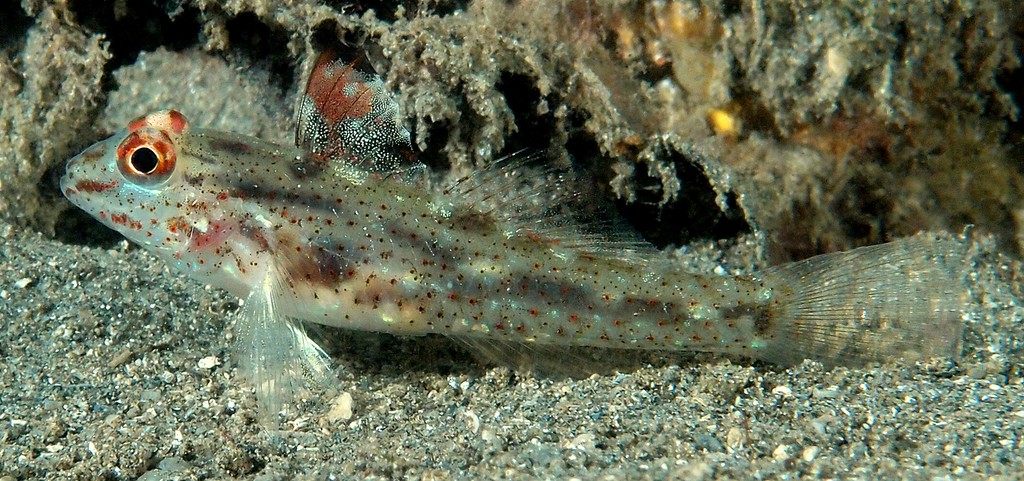FUSIGOBIUS SIGNIPINNIS - (HOESE & OKIBA, 1988)
Actinopterygii (Gigaclass) > Actinopteri (Class) > Teleostei (Subclass) > Gobiiformes (Order) > Gobioidei (Suborder) > Gobiidae (Family) > Gobiinae (Subfamily) > Fusigobius (Genus)
Fine-spotted sand-goby, Flasher sandgoby, Signal goby, Signalfin goby, Hirefuri sankaku haze, ヒレフリサンカクハゼ, 圣鲯塘鳢,
Synonymes
Coryphopterus signipinnis (Hoese & Obika, 1988)
Fusigobius signipirris (Hoese & Obika, 1988)
----------------------------
Description
Dorsal spines (total): 7; Dorsal soft rays (total): 9; Anal spines: 1; Anal soft rays: 8; Pectoral fin rays: 16-18 (usually: 17); 5th ray of pelvic fins less than two-thirds length of 4th ray; Longitudinal scale series: 23-25; Depth of body: 4.7-5.5 in SL. Pelvic fins united only at bases; Absence of pelvic frenum; Rounded caudal fin; Mainly ctenoid scales except cycloid on breast, base of pectoral fin and side of nape to above rear margin of preopercle; Scales absent on operculum; Median predorsal scales absent; Opening of gill extending to level slightly anterior to posterior edge of preopercle. Max. length: 4.9 cm SL. Depth range: 3 - 30 m, usually: 5 - 25 m.
Fine-spotted sand-goby, Flasher sandgoby, Signal goby, Signalfin goby, Hirefuri sankaku haze, ヒレフリサンカクハゼ, 圣鲯塘鳢,
Synonymes
Coryphopterus signipinnis (Hoese & Obika, 1988)
Fusigobius signipirris (Hoese & Obika, 1988)
----------------------------
Description
Dorsal spines (total): 7; Dorsal soft rays (total): 9; Anal spines: 1; Anal soft rays: 8; Pectoral fin rays: 16-18 (usually: 17); 5th ray of pelvic fins less than two-thirds length of 4th ray; Longitudinal scale series: 23-25; Depth of body: 4.7-5.5 in SL. Pelvic fins united only at bases; Absence of pelvic frenum; Rounded caudal fin; Mainly ctenoid scales except cycloid on breast, base of pectoral fin and side of nape to above rear margin of preopercle; Scales absent on operculum; Median predorsal scales absent; Opening of gill extending to level slightly anterior to posterior edge of preopercle. Max. length: 4.9 cm SL. Depth range: 3 - 30 m, usually: 5 - 25 m.
Color
Males have a taller, more heavily pigmented first dorsal fin; Translucent grey body color; Red-brown iris; Side of body with tiny brown to reddish spots; First two membranes of first dorsal fin with black tip and large brown blotch below; Caudal fin without markings; Males have a much taller, and more heavily pigmented first dorsal fin than females. Little geographical variation was noted.
Males have a taller, more heavily pigmented first dorsal fin; Translucent grey body color; Red-brown iris; Side of body with tiny brown to reddish spots; First two membranes of first dorsal fin with black tip and large brown blotch below; Caudal fin without markings; Males have a much taller, and more heavily pigmented first dorsal fin than females. Little geographical variation was noted.
Etymology
Fusigobius: from Latin, fusus = spindle + from Latin, gobius = gudgeon.
signipinnis: from Latin, signum = flag or sign + from Latin, pinnis = fin. Referring to the characteristic waving of the firs dorsal fin, exposing the black spot.
Original description: Fusigobius signipinnis Hoese & Obika, 1988 - Type locality: Lizard Island, between Bird and South Islands, Queensland, Australia, depth 20-22 meters.
Distribution
Eastern Indian Ocean, western Pacific: Indonesia east to Fiji and Tonga, north to Ryukyu Islands (Japan), south to northern Australia and New Caledonia.
Biology
Lives on patches of fine sand near coral rock or rubble of lagoon reefs. The species is often observed raising and lowering its dorsal fin.
Similar species
Fusigobius melacron (Randall, 2001) - Reported from New Caledonia - Link to the species (here).
Fusigobius: from Latin, fusus = spindle + from Latin, gobius = gudgeon.
signipinnis: from Latin, signum = flag or sign + from Latin, pinnis = fin. Referring to the characteristic waving of the firs dorsal fin, exposing the black spot.
Original description: Fusigobius signipinnis Hoese & Obika, 1988 - Type locality: Lizard Island, between Bird and South Islands, Queensland, Australia, depth 20-22 meters.
Distribution
Eastern Indian Ocean, western Pacific: Indonesia east to Fiji and Tonga, north to Ryukyu Islands (Japan), south to northern Australia and New Caledonia.
Biology
Lives on patches of fine sand near coral rock or rubble of lagoon reefs. The species is often observed raising and lowering its dorsal fin.
Similar species
Fusigobius melacron (Randall, 2001) - Reported from New Caledonia - Link to the species (here).
